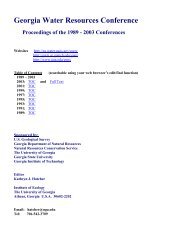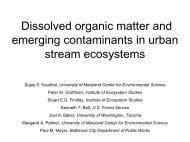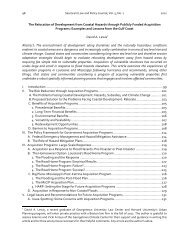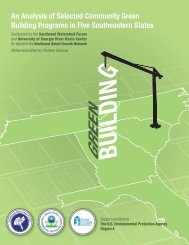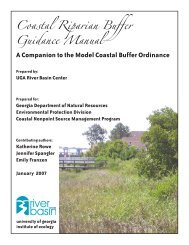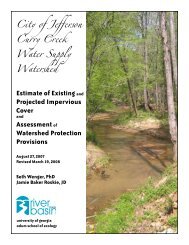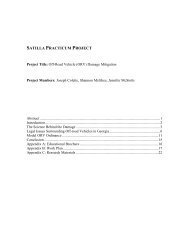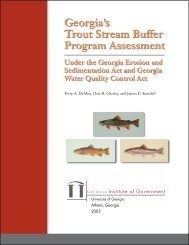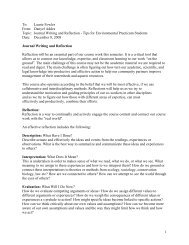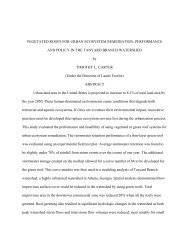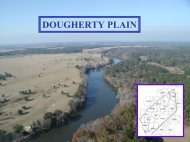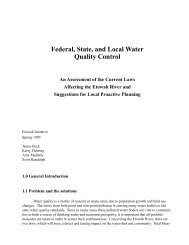1 Bibliographic Review of Sources Relevant to Development of Draft ...
1 Bibliographic Review of Sources Relevant to Development of Draft ...
1 Bibliographic Review of Sources Relevant to Development of Draft ...
Create successful ePaper yourself
Turn your PDF publications into a flip-book with our unique Google optimized e-Paper software.
Savannah River Annotated Bibliography: January 2003<br />
Middle River was considered suitable. Under low flow conditions: Portions <strong>of</strong> the<br />
Back River (up <strong>to</strong> 6.5 miles upriver <strong>of</strong> the Front River confluence) became<br />
unsuitable for striped bass eggs and larvae. Most <strong>of</strong> the Middle River except for the<br />
lowest reaches were suitable. The Front River had mostly <strong>to</strong>xic levels up <strong>to</strong> the<br />
Hoolihan Bridge (river mile 21.5). These flow levels are unlikely during the striped<br />
bass spawning season but serve as a ‘worst-case scenario’.<br />
Reinert, T.R., J. Wallin, and M.J. Van Den Avyle. 1996. Abundance and distribution <strong>of</strong><br />
striped bass eggs and larvae in the Savannah River estuary-Implications for channel<br />
dredging window, 1994-1996. Final Report, U.S. Army Corps <strong>of</strong> Engineers<br />
Savannah District. Georgia Cooperative Fish and Wildlife Research Unit, Daniel B.<br />
Warnell School <strong>of</strong> Forest Resources, University <strong>of</strong> Georgia, Athens, Ga. 30602.<br />
The general objectives <strong>of</strong> this study were <strong>to</strong> determine the timing <strong>of</strong> striped bass<br />
spawning, define the spatial distribution <strong>of</strong> eggs and larvae, and examine how watermass<br />
transport affects distribution <strong>of</strong> spawned eggs throughout the estuary. Most<br />
eggs (86%) were collected in the upper Front River (river miles 24-31). Most eggs<br />
(99.5%) were captured from March 23 <strong>to</strong> May 10 each year. Based on float study<br />
results, eggs spawned in the upriver areas (river miles 24-31) would be jeopardized<br />
by rapid transport <strong>to</strong> the harbor area, where they could be exposed <strong>to</strong> dredging and<br />
maintenance activities and areas <strong>of</strong> high salinity. Conversely, eggs spawned in the<br />
Back River area (Back River miles 10 and above) would, during periods <strong>of</strong> low river<br />
discharge, remain in the Back River.<br />
Rulifson, R. A. and C. S. Manooch III. 1990. Recruitment <strong>of</strong> Juvenile Striped Bass in<br />
the Roanoke River, North Carolina, as Related <strong>to</strong> Reservoir Discharge. North<br />
American Journal <strong>of</strong> Fisheries Management. 10: 397-407.<br />
Juvenile abundance index (JAI) values for young-<strong>of</strong>-year striped bass in Abermarle<br />
Sound (1955-1987) were compared <strong>to</strong> preimpoundment and post-impoundment<br />
flows <strong>of</strong> the Roanoke River during the spawning season. Recruitment was best (JAI<br />
> 5.0) for years in which river flows were low <strong>to</strong> moderate (5,000-11,000 ft3/s) and<br />
was poor (JAI < 5.0) when flows were very low (3.900-8,100 ft3/s) or high (10,000<br />
ft3/s or greater) during spawning season. Additionally, the average flow pattern for<br />
good recruitment years (JAI > 5.0) most closely resembled preimpoundment flow<br />
conditions. Preimpoundment flow patterns were used <strong>to</strong> develop a recommended<br />
flow regime for the lower river.<br />
Secor, D.H., T.E. Gunderson, and K. Karlsson. 2000. Effect <strong>of</strong> temperature and salinity<br />
on growth performance in anadromous (Chesapeake Bay) and nonanadromous<br />
(Santee-Cooper) strains <strong>of</strong> striped bass Morone saxatilis. Copeia. 2000, 291-296.<br />
Growth rates <strong>of</strong> striped bass Morone saxatilis were compared between anadromous<br />
(Chesapeake Bay) and nonanadromous (Santee-Cooper) s<strong>to</strong>cks. Early growth rates<br />
are probably inversely related <strong>to</strong> latitude. Growth rates for both s<strong>to</strong>cks at given<br />
temperatures and salinities are provided.<br />
Stevens, D.E. 1977. Striped bass (Morone saxatilis) year class strength in relation <strong>to</strong><br />
river flow in the Sacramen<strong>to</strong>-San Joaquin Estuary, California. Transactions <strong>of</strong> the<br />
American Fisheries Society. 106: 34-42.<br />
46



